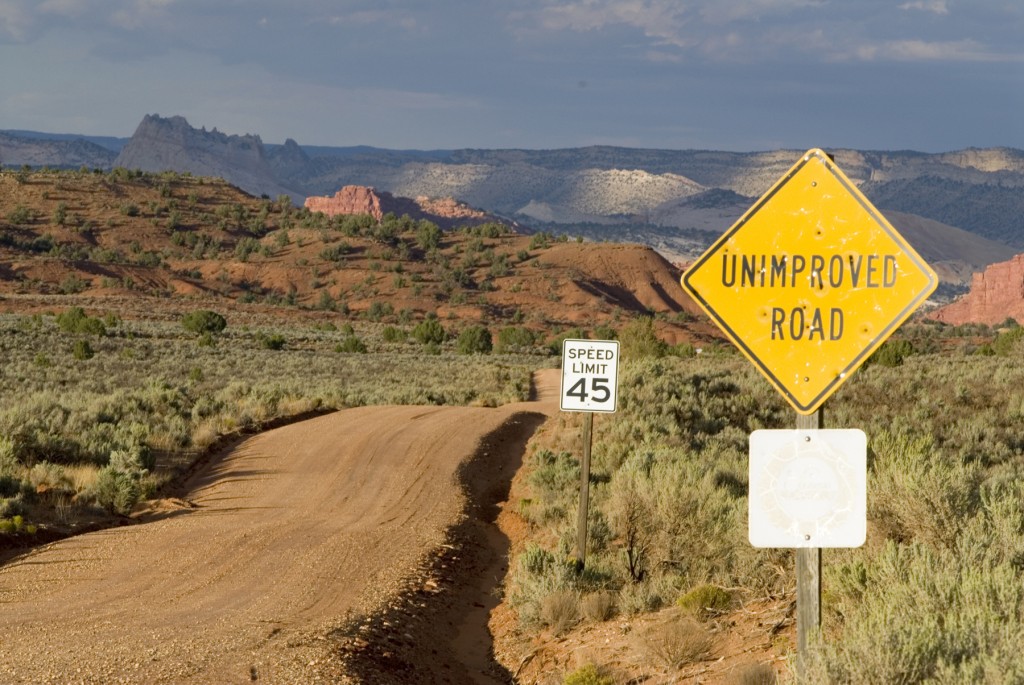
Although this may seem obvious, the one essential ingredient of a great river trip is an adequate river. Paddling an inflatable kayak down a stream without enough water, I’ve discovered, demands the combined skills of mogul skiing, skateboarding, stick fighting, pole vaulting, and bobsledding.
My friend Leon and I faced this riparian pentathlon one April on southern Utah’s Escalante River. When we reached the Escalante after driving one of the most dramatic routes in America, down Utah Highway 12 from Boulder Mountain–where bare aspens waited patiently for spring and a lone coyote stared at us from a snowfield–we searched for any sign of a river moving between its banks.
“It’s certainly well camouflaged,” I said.
Leon just whistled, then looked up at the sky as if expecting rain.
At the highway put-in, neither of us mentioned the obvious water shortage. I paced amid our chaos of kayaking and backpacking gear while Leon sat on the hood of his truck performing surgery on a pair of Teva sandals with dental floss, pliers, a sewing needle, and a spoon. We ate three-day-old sourdough bread, hard as a tire iron, and imagined mighty rivers: the Mississippi, the Columbia, the Colorado. Beside us, the Escalante doddered like a friendly drunk, just able to muster the energy to slide over shallow stones.
“I’ve seen more water flowing across my kitchen floor,” Leon finally said, “one time when the washing machine backed up.”
 If you consult a highway map of Utah and place your finger on the point farthest from an interstate, you’ll end up either on a missile-testing range or in the Escalante River. Named for a Spanish cleric who got nowhere near the river while searching for a new route between Santa Fe and Monterey, California, in 1776, the Escalante defied discovery by whites for another 100 years. John Wesley Powell twice floated past its mouth while exploring the Colorado River in 1869 and 1871, but never realized it was a major tributary. A year later, the Thompson-Dellenbaugh party mistook the Escalante for the Dirty Devil River and then, recognizing their error, claimed credit for finding it. It was the last river to be discovered in the contiguous United States.
If you consult a highway map of Utah and place your finger on the point farthest from an interstate, you’ll end up either on a missile-testing range or in the Escalante River. Named for a Spanish cleric who got nowhere near the river while searching for a new route between Santa Fe and Monterey, California, in 1776, the Escalante defied discovery by whites for another 100 years. John Wesley Powell twice floated past its mouth while exploring the Colorado River in 1869 and 1871, but never realized it was a major tributary. A year later, the Thompson-Dellenbaugh party mistook the Escalante for the Dirty Devil River and then, recognizing their error, claimed credit for finding it. It was the last river to be discovered in the contiguous United States.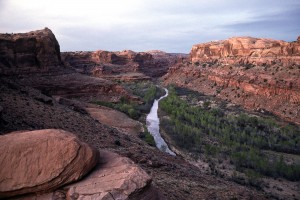
Bordered by the Circle Cliffs and Waterpocket Fold to the east, the Straight Cliffs of the Kaiparowits Plateau to the west, and the Aquarius Plateau to the north–and offering rim views of Navajo and Boulder mountains, and the solitary Henry range–the Escalante canyon is difficult to reach and well protected from sight. Before being uplifted some 60 million years ago, much of the region lay under an inland sea, collecting the colorful sediments that running water has since carved into fins, domes, alcoves, arches, and natural bridges, in shades of red, brown, purple, gray, and green. Side canyons branch off side canyons as if in some geologic pyramid scheme.
Every year, millions of visitors to Bryce, Zion, Arches, and Canyonlands national parks follow the examples of Father Escalante and Major Powell in bypassing these canyons on their way to other places. Yet a few backpackers do find their way here, and unfortunately that’s all it takes to shatter the isolation of the river and its tributaries–the visiting of which Leon and I selfishly, whole-heartedly, and hypocritically discourage. We worked hard to devise a way of having the Escalante to ourselves: the hanging gardens of purple columbine clustered around seeps in deep-red rock, the whispers of perfume from sage and desert holly, the rounded streambed stones that feel so smooth in your hands. And above it all, the slices of star-flaked sky viewed from sandy alcove camps, illuminated by a goofy, lopsided moon.
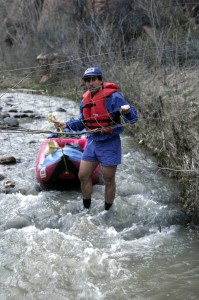 The Escalante is nearly always too shallow for rafts or canoes, and hard-shell river kayaks would have been too small for gear and too clumsy to pack out at the end. So we opted for inflatable kayaks, which seemed to us, planning from afar, to be custom-made for this trip. They would enable us to get to our designated take-out at Coyote Gulch, 80 miles downstream, far faster than if we went on foot, maximizing the amount of time that we could spend hiking the deepest sections of the Escalante’s otherwise inaccessible side canyons.
The Escalante is nearly always too shallow for rafts or canoes, and hard-shell river kayaks would have been too small for gear and too clumsy to pack out at the end. So we opted for inflatable kayaks, which seemed to us, planning from afar, to be custom-made for this trip. They would enable us to get to our designated take-out at Coyote Gulch, 80 miles downstream, far faster than if we went on foot, maximizing the amount of time that we could spend hiking the deepest sections of the Escalante’s otherwise inaccessible side canyons.
But the most compelling argument for this particular scheme was that we’d never actually heard of anyone traveling the Escalante by boat.
Yes, information on floating the river does exist, but it’s scarce; simply finding it constituted the first stage of our expedition. In his 1978 book Canyon Country Paddles, Verne Huser reports that “the Escalante has probably not been run by more than a dozen parties to date. It is a real wilderness river, tough to get out of once you are in it or on it… totally isolated most of the time. It is only for the adventuresome.” Many years after admonishing his readers to treat the Escalante “with reverence,” Huser still hadn’t gotten around to it himself.
Huser’s warnings were and remain on target: since the Escalante descends nearly 2,000 feet between the Highway 12 bridge and Lake Powell, river runners must either portage and paddle down to and then across the reservoir, or climb out from the depths, lugging their crafts through one of only two negotiable side canyons. In the event of a minor injury sustained by a person, or an irreparable one suffered by a kayak, the hike back to civilization could take days: the sheer walls would dictate a circuitous route, and once out of the canyon one might have to trudge as much as 50 miles on the desolate, dead-end Hole-in-the-Rock Road west of the river to Escalante, the nearest town. Because Leon had borrowed our $700 kayaks from the river outfitter he guides for, leaving them behind would be an option only in the most life-threatening emergency. We knew we’d have to lug the boats up to the canyon rim eventually, but treated this fact like an inevitable root canal, putting it out of our minds until we had to confront it.
The only other information I uncovered was a two-page pamphlet bearing the logos of the Department of the Interior, the National Park Service, and the Bureau of Land Management. That so many government agencies even knew about floating the Escalante was discouraging, but I thoroughly approved of the text’s pessimistic tone: “The river’s potential for river running is of a limited nature,” it reads. “It will be extremely important to plan your float to catch high-water periods. This will require flexibility in your schedule and frequent updating of river conditions.”
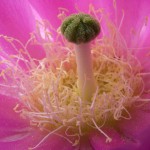
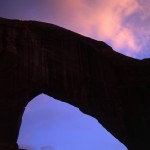
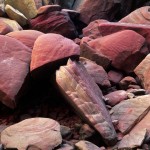
Planning this journey from 2,000 miles away severely limited that flexibility. We chose a week in April, when our chances of catching high runoff would be best. We decided to make the trip even if we had to drag and carry our boats the entire way (which seemed to be a real possibility those first few miles). Locked into a specific week, that “frequent updating” of river conditions became unnecessary. But we compensated by updating them often once we’d begun.
“It’s still pretty shallow,” I would say a few times daily, water sloshing against my ankles. “Yep,” Leon would add, dragging his boat over a sandbar. “Still shallow.”
That first day, after putting in just before evening, we made two miles on the low water. The river flowed over old beaver dams, between rocks and gravel bars and, in two places, under fences. We learned to negotiate rocky shoals and sharp corners by pushing off trees, sandbars, and even the river bottom like Italian gondoliers. We climbed out of our boats to drag them like reticent dogs to the vet’s door; pedaled them with one foot on a gunwale and one in the river; and pushed until the boats slid off the bottom and we could jump aboard before they floated empty downstream.
At dusk, when the water turned a flat copper and the sun dusted the canyon tops with orange light, we camped on a sandy beach. Leon pointed out that we had only 78 miles left to paddle in six days, and we still needed to find time to explore the several hundred side canyons along the route.
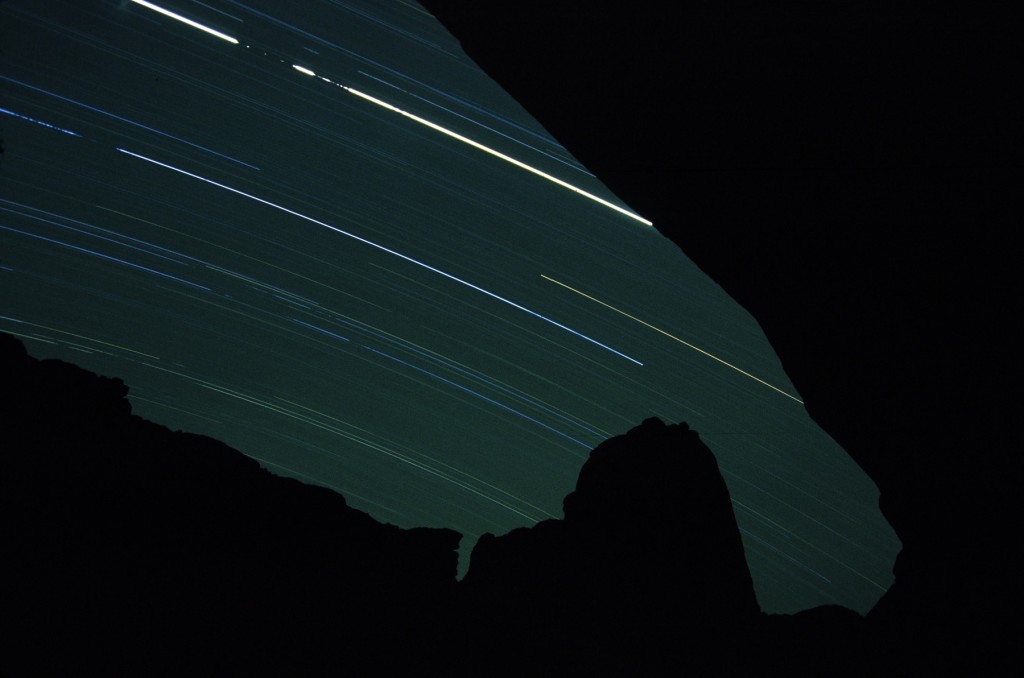
Through the second morning, Leon and I steadfastly ignored even the most enticing side draws in the interest of maintaining downstream momentum, hoping that tributaries would soon increase the river’s flow. After pushing and dragging our way three more miles downriver, we saw the clear, blue water from a creek double the muddy Escalante’s volume, and so felt justified in exploring beyond the willow and tamarisk choking the side canyon’s mouth.
Just inside, the brush fell away, revealing a musical stream rippling through a gravelly wash. A few minutes later, we noticed a spot where water careening around a curve centuries ago had carved an alcove in the orange rock. Our climb up to it was rewarded by the discovery of white arrowheads, pottery shards blackened from firing, and petroglyphs etched into the canyon walls by the Anasazi.
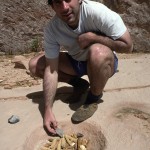
Throughout the Four Corners region of the Southwest, the Anasazi chose dramatic locations to develop their canyon real estate. Their sophisticated culture disappeared without explanation 700 years ago–whether from drought, attack by enemies, or catastrophic disease, experts can only conjecture. But they left messages that have survived the centuries, and that reverberate through these canyons in the forms of skillfully worked stone, well-concealed cliff dwellings, human handprints pressed with red dye on alcove walls.
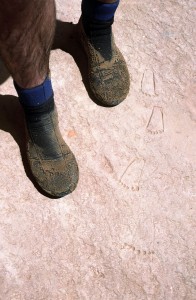 Farther downriver, a scramble up another side stream brought us to a pair of high recesses full of more pottery, and metates–where Anasazi women had worn smooth, wide grooves in flat stones by grinding corn. From the higher alcove, we stood looking at the ribbon of the Escalante, flowing the color of wheat beer down below. We considered the view for a minute or more before noticing a fully intact stone-and-mortar granary 20 feet away, tucked against the back wall. Its opening was inlaid with cottonwood boughs carefully set there a millennium ago. Inside, the structure was full of corncobs, as if the residents had only left a short time ago.
Farther downriver, a scramble up another side stream brought us to a pair of high recesses full of more pottery, and metates–where Anasazi women had worn smooth, wide grooves in flat stones by grinding corn. From the higher alcove, we stood looking at the ribbon of the Escalante, flowing the color of wheat beer down below. We considered the view for a minute or more before noticing a fully intact stone-and-mortar granary 20 feet away, tucked against the back wall. Its opening was inlaid with cottonwood boughs carefully set there a millennium ago. Inside, the structure was full of corncobs, as if the residents had only left a short time ago.
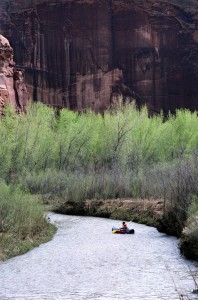
It wasn’t until our third afternoon that the Escalante flowed quickly enough to make the kayaking almost like kayaking, and we made better mileage–meaning that we fell only slightly farther behind schedule. But then we were distracted by a third side canyon, where a boulder-strewn creekbed wound through oak and box eider, waterfalls slid down rock faces, and dry leaves piled on the floor like discarded parchment. Returning to the river a bit later, we ate lunch leaning against the warm tubes of our kayaks and tossed out the itinerary so painstakingly put together over the previous months. Having already passed dozens of alluring side canyons, we knew we had to slow down and explore. We were working too hard just to finish the trip we’d designed; counting miles, we rationalized, wasn’t our primary goal.
We were still 70 miles from our take-out at Coyote Gulch. To meet our waiting shuttle driver there might require dawn-to-dusk paddling without a single side trip. So we made an executive decision to pull out at Fence Canyon, 35 miles earlier–the only other exit route we could safely negotiate with all our gear. With good timing, we might even be able to catch our driver on his way to Coyote Gulch.
It was a liberating decision. We hiked up a sand dune just for the pleasure of running back down, bushwhacked through yucca and prickly pear and barrel cactus, clinging to steep slopes just to see the view from above. We chimneyed up rock slots and swam cold pools when the canyons beyond looked promising. We paddled and drifted along the cool river in the hot sun, through the canyon country’s curving topography. Leaning our heads back as our boats moved in the lazy flow, we stared up between desert-varnished walls at cobalt sky.
And we talked. Leon, who’d lived in his truck for seven out of the past ten years, told me how he’d always felt at home anywhere his radio could pick up a baseball game being played at night. I admitted that I’d always been competitive with my father, but now that he was growing older, I rooted for him to win when we played sports. This prompted Leon to test my will to win: he offered me $100–a veritable fortune to him–if, at the end of our trip, I would drink a soup made from hot water and my own dirty socks.
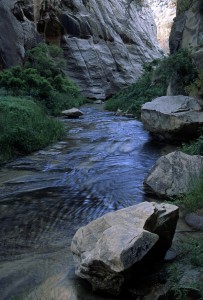
With our new, free-flowing itinerary, we laid over one day at a camp just up from the mouth of Harris Wash, where an elegant grove of cottonwoods clustered on a wide beach, bright green against the red- and black-streaked rock. From here we explored the damp, shady undulations of the wash as well as dry Silver Falls Canyon, where the purple streambed stone was littered with black chunks of petrified wood.
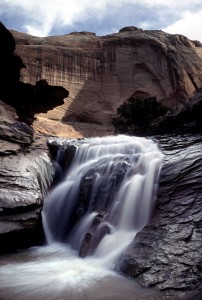
A mile or so up Silver Falls, we came upon an inscription carved into an alcove by one G.B. Hobbs in 1883. Hobbs, a Mormon pioneer on his way to Bluff, Utah, was caught in a snowstorm here, and chipped his name in the rock as a sort of farewell (although, it turns out, he survived the storm). In another alcove high above the Escalante, we discovered the signatures of more-recent visitors. As early as 1887, according to the chiseled graffiti–and many times since–canyon hikers such as “Ethel” and several members of the Lyman family thought themselves of enough historical significance to deface not just the walls, but also a panel of pictographs left by the Anasazi.
Leon and I contemplated these messages left in various ages by different cultures, and wondered at the fact that the ancients had chosen to glorify the natural and spiritual worlds, whereas modern visitors had felt the need to glorify themselves.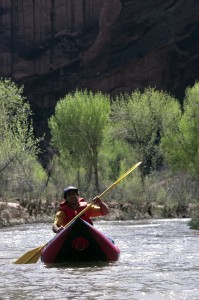
By our seventh and final day on the Escalante, we’d seen only five other people, all of them camping in Harris Wash (the western end of which is only a few miles from the end of a dirt road). As measured by solitude and side canyons, the trip had been a great success. Measured by the climb out of the main canyon, still to come, we should have left the $700 kayaks behind.
That morning we deflated and rolled up the boats, and gathered all the accompanying gear: life vests, paddles, patch kit, inflatable floors, hand pumps, dry bags, and bailers. These we overstuffed into, strapped onto, and hung out of internal-frame backpacks already full of such essentials as extra food and clothing, stoves, sleeping bags, a tent, and plastic flasks emptied of Kahlua, with which we’d concocted “mountain mochas” after dinner each night.
Previous experience had taught me that boats were designed to carry people, and not the other way around. And although reversing roles can improve virtually any relationship, we gained little insight into our kayaks by hauling them out on our backs. It took several hours to stagger up Fence Canyon, which climbs a torturous 900 feet in 3.5 miles. Our legs occasionally buckled under the weight of the loads, so we stopped often to rest in the scant shade of stunted juniper, where the temperature “cooled” to 105 degrees. The final quarter-mile pitch seemed nearly vertical, and I had to pull on boulders and yucca stems to hoist myself forward, counting out three or four steps before stopping to catch my breath. Goals and finish lines, which we’d sloughed off so successfully on the river, had returned with a vengeance.
Finally, dragging our 90-pound packs over the rim, we celebrated with a quick lunch of smoked salmon on rye crackers and drank in the view: rolling plains of petrified red dunes, sliced by steep canyons. In the middle distance, a green curl of trees revealed the Escalante–but only because we knew it was there. Beyond, snow still clung to Boulder Mountain, where we’d camped a week ago and woken up looking like glazed doughnuts in the frost.
As soon as we’d finished eating and quaffing a quart of water each, Leon headed back down to the river to retrieve another oversize load of gear, and I began the ten-mile chase across a bone-dry landscape to Hole-in-the-Rock Road, where I hoped to intercept Barry, the shuttle driver, our only means of getting back to town.
I reached the gravel road 15 minutes before Barry came driving by. He nearly sped past after glancing at me in a way that informed me of how bad I must have looked: bearded and sunburnt, covered with sweat and road dust, hair wild, lips cracked, arms and legs scarred, punctured, scraped, lacerated, and burnt, my whole demeanor tired and sore and a little crazy.
As we returned to the canyon rim along the dusty miles of dirt road I’d just walked–on our way to pick up Leon, who looked even worse than me–I conjured up images of smooth river rocks, feathery cascades, and explosions of columbine. It was a vision to keep as private as possible–so if all Barry saw was one very haggard hiker, that was perfectly fine with me.
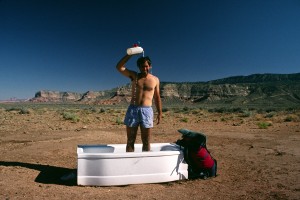
All photos courtesy of Leon Werdinger, www.ottertrack.com
